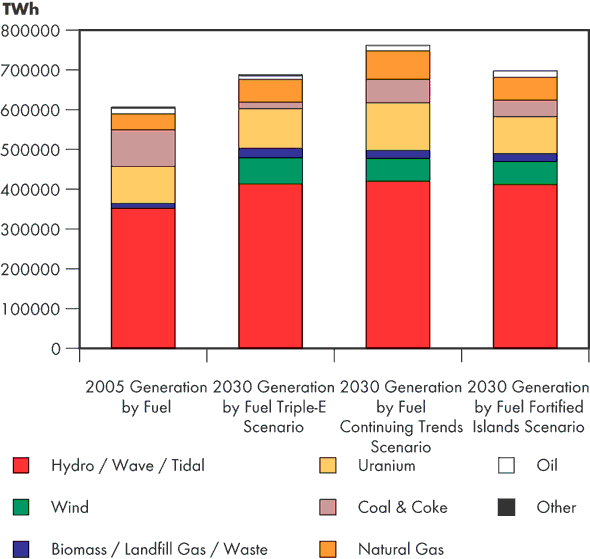ARCHIVED - Fact Sheet - Canada's Energy Future: Reference Case and Scenarios to 2030 - Electricity Highlights
This page has been archived on the Web
Information identified as archived is provided for reference, research or recordkeeping purposes. It is not subject to the Government of Canada Web Standards and has not been altered or updated since it was archived. Please contact us to request a format other than those available.
Fact Sheet - Canada's Energy Future: Reference Case and Scenarios to 2030 - Electricity Highlights
Canada's electricity markets have developed along provincial or regional boundaries and adequate supply provides economic and reliability benefits to each area. Each region strives to ensure that mechanisms are in place to mitigate the potential for tightness in supply, or even a shortfall. While most regions are self-sufficient in generation capacity, many realize the benefits from interprovincial and international trade by taking advantage of differences in generation fuel types and peak demand periods between trading regions.
1. Significant changes are expected in the electricity supply sector.
Many of the changes come from recent and anticipated decisions on electricity generation and transmission, including a number of provincial policy changes and federal regulatory decisions. In Ontario, for example, the phasing out of coal plants by 2015 will lead to a resurgence in nuclear energy. Many provinces are also encouraging the development of emerging technology projects such as Quebec's plans for wind development.
New interprovincial transmission projects between Ontario and Quebec and a new international connection between Alberta and Montana will also impact the Canadian electricity sector. In both cases, imports and exports will increase providing Canada with economic and reliability benefits.
Although conventional generation will provide the majority of the energy in all scenarios, emerging technologies such as wind power, biomass and smaller hydro electric production facilities will be added to the generation mix. This is especially true in the Triple E scenario. But in order to have these emerging technologies integrated effectively into the production and transmission systems, new policies and regulations need to be implemented.
Nuclear power will also increase in all three scenarios. This is due to the construction of new nuclear plants to replace older nuclear and coal plants.
2. Provincial exchanges of electricity and exports to the United States increase in all three scenarios.
In the Fortified Islands and Triple E scenarios, demand is expected to peak and then begin to decline. In the Triple E scenario, this decline will start after 2016 due to changes in social values and energy demand management policies. The demand decrease will begin after 2020 in the Fortified Islands scenario because of high energy prices and slower income growth. Once Canadians have adjusted to the higher prices, demand will stabilize.
In both cases, the reduction in domestic demand leads to an increase in exports and interprovincial trade. The highest Canadian exports occur in the Fortified Islands scenario with a 300 per cent increase from 2006 to 2030. Interprovincial transfers of electricity increase to a lesser degree.
In the Fortified Islands scenario, high fossil fuel prices will result in more electricity being generated from wind and hydro power. In the Triple E scenario, wind and hydro power will again be strong because they are greenhouse gas neutral forms of generation. Hydro generation will also meet increasing demand in the Continuing Trends scenario, but overall, a tightening in domestic hydro supply will reduce the opportunity for this type of energy export to the U.S.
3. New electricity transmission is required to support new generation.
In the three scenarios considered, new transmission will be required within provinces to support new generation. Existing plants in some provinces reach the end of their 40-year economic life and need to be assessed for upgrades and viability. If large hydro developments in Newfoundland and Labrador, Quebec, Manitoba and British Columbia are constructed, these projects will require substantial additions to the transmission systems.
Electric Generation by Fuel and Scenario

There will also be a need for increased interprovincial connections to expand transfers of electricity between provinces. Finally, Canada and the United States will also need to increase transmission line capacity to enable increased exports to the U.S.
Conclusions
With electricity prices expected to increase, Canadians will likely adjust their energy consumption behaviour in order to manage these increasing costs. Conventional technologies will continue to dominate electricity generation. However, new emerging technologies including alternative energy resources, such as wind power, small hydro and biomass projects, will have an increasing share of the generation mix. Infrastructure will be needed to accommodate the integration of more resources and expanded electricity trade.
- Date modified:
